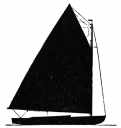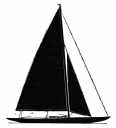 |
| The points of sailing (shown in Figure
3) are terms of general reference with the wind at different angles
to the centerline of your sailboat. The purpose of this section is
to provide a review of earlier instruction and an overview of the
basic concepts. Starting with the No. 1 position, the boat is shown
headed into the wind with the sail luffing as it would be when at
the mooring. |
 |
The boat in position No.
2 is sailing as close to the wind as possible, actually 45 degrees
from the wind direction or axis. When sailing CLOSE HAULED (position
No. 2) the sails are hauled in to the stern corner of the boat
as far and as flat as possible and still have draft (curve) enough
to propel the boat.Since the sail luffs when the boat reaches 45 degrees
from the wind’s axis, it is evident that there is a total angle
of 90 degrees in which it is not possible to sail. |
| To reach a destination in this quadrant it is necessary to make
a series of TACKS with the wind first on one side of the boat then
on the other, zigzagging at angles 45 degrees from the wind’s
axis. This is called BEATING TO WINDWARD and the boat is said to be
CLOSE HAULED or ON THE WIND. The technique used in sailing to windward
is to leave the sail trimmed in the same position over the corner
of the stern and adjust the course of the boat to any variations in
the wind’s direction while keeping the sail at the luffing point.
The sail should be let out only if the boat tips excessively to leeward.
The boat in position No. 3 is REACHING
with the wind at right angles to the boat’s course. The point
of sailing is a BEAM REACH and is off-the-wind or sailing free. The
technique for sailing a course is to keep the boat on a straight course
and adjust the sail until it is trimmed in just enough to keep it
from luffing. Luffing will start at the section of the sail near the
mast and it is this section which must be watched closely. |
| To check sail trim, let the sail out until it starts
to luff and then trim it in only enough to stop luffing. The sail
is adjusted to variations in the wind’s direction and the course
is kept steady. It should be noted that in the case of boat No.
2, sailing to windward, close hauled, the course of the boat is
altered with the variations in the wind’s direction while in
the case of boat No. 3, on a reach,
the trim of the sails is altered and the boat’s course held steady.
In both instances the luff of the sail near the mast is kept just
at the luffing point. Boat No. 4 is
headed on a course 135 degrees away from the wind’s axis with
the wind blowing over the stern quarter. |
 |
This point of sailing is called BROAD REACHING and may also be designated
as OFF-THE-WIND, a term used to designate all courses not close hauled.
Position No. 5 shows the boat sailing
directly BEFORE THE WIND. Since the wind’s axis corresponds with
the centerline and course of the boat, the sail could be carried on either
side. The maneuver of changing the sail from one side to the other is
called JIBING (also GYBING). Jibing is accomplished by moving the tiller
away form the sail and trimming in the sail and then letting it run out
quickly on the other side. When the wind is blowing slightly over the
same side that the sail is on, you are SAILING-BY-THE-LEE. If sailed too
much by the lee, the boat may accidentally jibe when the skipper does
not expect it. Accidental jibes are our most frequent cause of swampings
because the skipper is caught off balance and is on the wrong side of
the boat.
Boat No 6 having jibed, is shown BROAD
REACHING, as was boat No. 4, but on the starboard tack. No.
7 boat is shown on the starboard tack and is on a beam reach corresponding
to No 3. Boat No.
8 is shown on a CLOSE REACH which is similar to the beam reach shown
in position No. 3, but with sails almost
close hauled.
Tacking is the maneuver of turning the bow of the boat through the eye
of the wind so the sail swings from one side to the other and is shown
by the three positions, Nos. 8, 1, and 2.
 |
|
- Diagrams and Text courtesy of Sailing and the Tech Dinghy
- Permission granted by: Harold "Hatch" Brown, MIT.
- Black and white clipart were provided by
arttoday.com
- Created by: Nondini Naqui '02
- Maintained by: Bonnie Dix
- Date Created: 7/27/00
- Last Modified: 8/9/00
|
|



